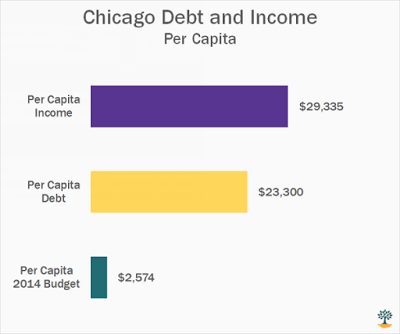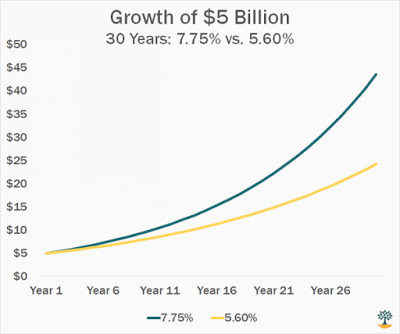Looking for a reason Chicago bonds are rated junk?
This guest post by Michael Johnston at Fixed Income Database explains why Chicago is junk in seven easy to understand charts.
Chart #1: Massive Debt Burden
Simply put, Chicago is shouldering an enormous amount of debt. By some calculations, the city is on the hook for as much as $63 billion when pensions, long-term notes, and health insurance obligations are included. That amounts to a staggering $23,300 for every inhabitant of the city, representing a huge chunk of the annual income for the city’s residents and nearly 10 times the size of the per capita annual budget.
Data Sources: Illinois Policy Institute, 2010 Census, Chicago Budget. Per capita income estimate is for Cook County.
Chart #2: Growing Payments
While the current state of the city’s balance sheet is dismal, the real problem relates to what is expected to develop over the next decade. Chicago pension plan payments are expected to double from 2014 to 2015, and will then continue to rise for another decade before they begin to decline. By the time payments peak in 2026, they will be four times the 2014 level.
Data Source: Moody’s estimates
Chart #3: Limited Taxing Ability
The easiest way for a government to boost revenues is through tax increases. For cities, property taxes are often a primary revenue stream. While it is certainly possible that Chicago will raise property taxes — in fact, it’s a near certainty — there will be a limit to the increases possible. Illinois residents already pay the second-highest property taxes in the country.
Data Source: WalletHub
Chart #4: Unrealistic Expected Rates of Return
The city’s pension liabilities have ballooned in part as a result of unrealistic expectations for the returns on the assets. For fiscal 2013, Chicago’s various pension plans were assuming annual rates of returns ranging from 7.5 percent to 8.25 percent.
Unfortunately, the actual performance has failed to live up to these lofty expectations. The Municipal Employees’ Annuity & Benefit Fund of Chicago (MEABF) reported a 10-year average return of just 5.6 percent as of 2014. The Laborers & Retirement Board Employees’ Annuity & Benefit Fund of Chicago (LABF) reported a “gross of fees” return of 6.3 percent for the 10 years ended March 31, 2015.
10-year returns as of 12/31/14 for MEABF and 3/31/15 for LABF. 5-year returns as of 12/31/13 for Police.
When the actual results fall short of expectations for an extended period of time, the gap between assets and liabilities can begin to rapidly grow. That’s exactly what has happened to Chicago’s pension plans; despite paying millions of dollars in fees — the police pension fund doled out over $8.6 million to managers and consultants in 2013 — returns have fallen far short of expectations.
Chart #5: Compounding Unrealistic Rates of Return
The disconnect between the expected returns used by Chicago’s pension funds and reality are disappointing. But when they continue over an extended period of time, this gap can spell economic disaster. The difference between 7.75 percent and 5.60 percent in annual returns may not seem like much, but when these rates of return compound, a massive gap appears
The MEABF pension fund has been assuming that its approximately $5 billion of assets will grow to about $9.8 billion over the course of 10 years. Based on historical returns, it will actually grow to $8.2 billion — leaving a gap of nearly $600 per resident. This same scenario is playing out across multiple pension funds, for even longer periods of time.
Chart #6: Accelerating Expenses
Although Chicago has increased revenue through a number of different tax strategies, expenses have been rising considerably in recent years as well.
Data Source: City of Chicago Annual Budget for 2013, 2014, and 2015
Chart #7: Actual Junk
While Chicago’s budget issues are largely related to an underfunded pension system, the city isn’t exactly frugal in the way it spends money for other services. Many of the day-to-day aspects of city operations are extremely inefficient and expensive relative to other major metropolitan areas.
Data Source: Citizens Budget Commission
Reducing the cost of trash pickup obviously won’t solve all of Chicago’s problems; this service accounts for only a small fraction of the city’s budget. But the cost differences relative to other major American cities highlight the general lack of fiscal discipline that plagues the city.
The above charts and analysis courtesy of Michael Johnston at Fixed Income Database.
- English (UK)
- English (India)
- English (Canada)
- English (Australia)
- English (South Africa)
- English (Philippines)
- English (Nigeria)
- Deutsch
- Español (España)
- Español (México)
- Français
- Italiano
- Nederlands
- Português (Portugal)
- Polski
- Português (Brasil)
- Русский
- Türkçe
- العربية
- Ελληνικά
- Svenska
- Suomi
- עברית
- 日本語
- 한국어
- 简体中文
- 繁體中文
- Bahasa Indonesia
- Bahasa Melayu
- ไทย
- Tiếng Việt
- हिंदी
Seven Charts Explain Why Chicago Bonds Rated Junk
Published 06/10/2015, 04:14 AM
Updated 07/09/2023, 06:31 AM
Seven Charts Explain Why Chicago Bonds Rated Junk
3rd party Ad. Not an offer or recommendation by Investing.com. See disclosure here or
remove ads
.
Latest comments
Install Our App
Risk Disclosure: Trading in financial instruments and/or cryptocurrencies involves high risks including the risk of losing some, or all, of your investment amount, and may not be suitable for all investors. Prices of cryptocurrencies are extremely volatile and may be affected by external factors such as financial, regulatory or political events. Trading on margin increases the financial risks.
Before deciding to trade in financial instrument or cryptocurrencies you should be fully informed of the risks and costs associated with trading the financial markets, carefully consider your investment objectives, level of experience, and risk appetite, and seek professional advice where needed.
Fusion Media would like to remind you that the data contained in this website is not necessarily real-time nor accurate. The data and prices on the website are not necessarily provided by any market or exchange, but may be provided by market makers, and so prices may not be accurate and may differ from the actual price at any given market, meaning prices are indicative and not appropriate for trading purposes. Fusion Media and any provider of the data contained in this website will not accept liability for any loss or damage as a result of your trading, or your reliance on the information contained within this website.
It is prohibited to use, store, reproduce, display, modify, transmit or distribute the data contained in this website without the explicit prior written permission of Fusion Media and/or the data provider. All intellectual property rights are reserved by the providers and/or the exchange providing the data contained in this website.
Fusion Media may be compensated by the advertisers that appear on the website, based on your interaction with the advertisements or advertisers.
Before deciding to trade in financial instrument or cryptocurrencies you should be fully informed of the risks and costs associated with trading the financial markets, carefully consider your investment objectives, level of experience, and risk appetite, and seek professional advice where needed.
Fusion Media would like to remind you that the data contained in this website is not necessarily real-time nor accurate. The data and prices on the website are not necessarily provided by any market or exchange, but may be provided by market makers, and so prices may not be accurate and may differ from the actual price at any given market, meaning prices are indicative and not appropriate for trading purposes. Fusion Media and any provider of the data contained in this website will not accept liability for any loss or damage as a result of your trading, or your reliance on the information contained within this website.
It is prohibited to use, store, reproduce, display, modify, transmit or distribute the data contained in this website without the explicit prior written permission of Fusion Media and/or the data provider. All intellectual property rights are reserved by the providers and/or the exchange providing the data contained in this website.
Fusion Media may be compensated by the advertisers that appear on the website, based on your interaction with the advertisements or advertisers.
© 2007-2024 - Fusion Media Limited. All Rights Reserved.
